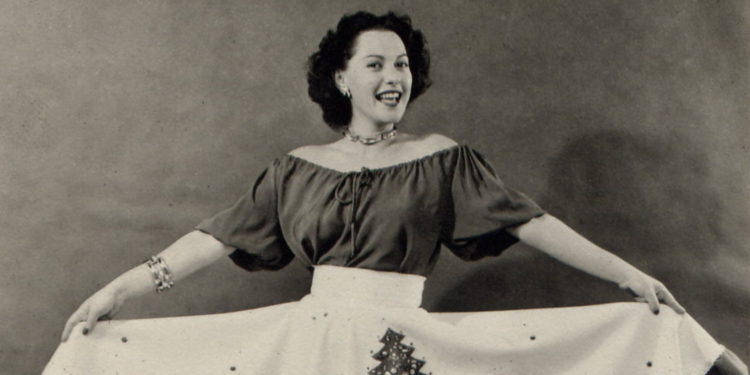By THE NEW YORK TIMES
What’s a nice Jewish viscountess to do when she has a title but no money, a party invitation but no clothes and a pair of scissors but no sewing skills?
Invent the poodle skirt, of course.
That, quite by accident, is what Juli Lynne Charlot did in late 1947, in the process creating a totem of midcentury material culture as evocative as the saddle shoe, the Hula-Hoop and the pink plastic lawn flamingo.
Ms. Charlot, a New York native who died at her home in Tepoztlán, Mexico, on Sunday at 101, had been a Hollywood singer before her marriage in the mid-1940s to a viscount, or British nobleman. Fashion conscious but hopeless with a needle, she stumbled by necessity onto a pattern for a striking skirt that involved no sewing: Take a large swath of solid-colored felt, cut it into an expansive circle, adorn it with jaunty appliquéd figures in contrasting colors, snip a hole in the center and pop yourself in.
The result, the embellished circle skirt, was ubiquitous throughout the 1950s, bought in droves by women and, in particular, adolescent girls. With its voluminous fabric that flared prettily when the wearer twirled, it was just the thing for a sock hop.
Over the years, circle skirts by Ms. Charlot and her many imitators came adorned with a range of figurative appliqués, often comprising small visual narratives. But because the garment’s most popular incarnation sported images of poodles, all such skirts came generically to be known as poodle skirts.
“When I was a teenager, every girl in the entire Western world wore a poodle skirt,” the humorist Erma Bombeck wrote in a 1984 column. She went on to define it as “a skirt with enough cloth to slipcover New Jersey with a big poodle appliquéd on it.”
Born quite literally of postwar abundance — fabric was no longer in short supply — the poodle skirt merged seamlessly with the youth culture of the 1950s, a set of glad rags that appeared to presage a carefree era. Never mind the Cold War, the skirt seemed to say: We’re gonna rock around the clock.
In later years, the poodle skirt became visual shorthand for the entire decade. Even now, a production of “Grease” or “Bye Bye Birdie” can scarcely be mounted without one in evidence.
The daughter of Phillip and Betty (Cohen) Agin, Jewish immigrants from Eastern Europe, Ms. Charlot was born Shirley Agin on Oct. 26, 1922, in Manhattan.
When she was a child, her family moved to Southern California. There, her father, an electrician, and her mother, an embroiderer, plied their trades at Hollywood studios.
“It was easier to be poor in a benign climate,” Ms. Charlot said in 2017, at 94, in an interview for this obituary that ranged over her singing career (“I still have a voice, by the way”); her improbable stage appearances with the Marx Brothers (“I was very beautiful then”); her penchant for marriage and romance (“I was always in love with somebody”); and her work as a self-taught fashion designer.
Young Shirley’s school friends included entertainers-to-be like the future Judy Garland, the future Ann Miller and the future Lana Turner. Possessed of a fine soprano voice, she began taking voice lessons at 13, determined to become an opera singer. “I was going to be the greatest exponent of Mozart,” she said.
Because she thought Shirley no fit name for a diva, she adopted the professional name Juli Lynne.
After graduating from Hollywood High School, she sang with the Los Angeles Civic Light Opera and with Xavier Cugat’s orchestra. During World War II she appeared with the Marx Brothers on a tour of stateside military bases.
Throughout her performing years, she designed her own wardrobe. Because she had refused to learn to sew (“I didn’t want to be a drudge, like my mother,” she said), she hired a seamstress to realize her designs in cloth.
Ms. Charlot had no shortage of “celebrity admirers,” she said, among them Harold Lloyd, Gary Cooper and Isaac Stern, the violinist.
She married four times, “to two millionaires, a royal count and a son of a” — and here she paused for dramatic effect — “baron.”
The first marriage, to the first millionaire, “didn’t really count,” Ms. Charlot said. They were divorced after three days.
Just after the war, she eloped to Las Vegas with Philip Charlot, an officer in the British Royal Navy. The son of a French father and an English mother, he was also, she learned only later, a viscount.
At his request, she gave up her career, settling for life as a stay-at-home viscountess. Her husband found work as a Hollywood film editor.
In December 1947, she was invited to a Hollywood Christmas party. She had nothing suitable to wear and no money: Her husband had recently lost his job.
A fairy godmother intervened in the person of Ms. Charlot’s mother, who by then had a small children’s wear factory. She gave her daughter a vast sheet of white felt.
Out came the scissors, and before long, Ms. Charlot found herself at the center of a white circle skirt.
“I worked out the hole with my brother’s slide rule: C = 2πr,” she said in 2017. She could sew just well enough by hand to appliqué green felt Christmas trees onto the background.
“My mother had a cigar box full of little tchotchkes that she used in her work,” she said. “Those went onto the Christmas trees as decorations.”
The skirt was “a huge hit” at the party, she recalled.
She made several similar skirts and took them to a Beverly Hills boutique. They sold out.
After the holidays, the store requested a nonseasonal design. She created a tableau of dachshunds chasing each other around the skirt. Once the dachshunds sold, the store suggested she turn her attention to poodles. French poodles were très chic at the time, and many customers owned them.
The poodles pummeled the dachshunds.
Before long, Ms. Charlot had a poodle-skirt factory. She made skirts adorned with images of frogs and lily pads, Parisian street scenes, galloping racehorses, cascading flowers, and champagne glasses and pink elephants, along with coordinating blouses, dresses, hats and handbags.
By the early 1950s, her skirts were selling for about $35 apiece — some $400 in today’s money.
Because Ms. Charlot’s business skills were, by her own account, on par with her sewing, her factory floundered at first. “Mother hocked her diamond ring three weeks in a row to help me meet the payroll,” she told the news service United Press in 1953.
But with the help of an investor — and with orders from exclusive department stores, including Bullock’s Wilshire in Los Angeles, Neiman Marcus in Dallas and Bergdorf Goodman in New York — her future was assured.
Today, Ms. Charlot’s skirts are prized by collectors of vintage clothing and can sell for many hundreds of dollars each.
Ms. Charlot’s marriage to her viscount did not endure. At the height of her success as a designer, she was summoned to tea by his mother. “The more successful you become, the less successful he becomes,” she recalled her mother-in-law saying. “You are destroying my son.”
Though Ms. Charlot loved her husband deeply, she gave him a divorce, she said, so he could recoup his life.
Ms. Charlot’s third marriage, to the second millionaire, ended in divorce, as did her fourth, to the Mexican-born son of a German baron. He had not troubled to tell her, she discovered, that he had been married to two women previously and had never quite bothered to divorce either.
Ms. Charlot leaves no immediate family.
In later years, Ms. Charlot, whose death was confirmed by her friend Carol Hopkins, manufactured contemporary renditions of traditional Mexican wedding dresses. She had lived in Tepoztlán, south of Mexico City, since the 1980s.
By the height of the Swinging Sixties, the miniskirt had put paid to the poodle. But before that happened, a young woman was captured in a press photograph that betrayed the reach of Ms. Charlot’s work.
The time was 1951, and the place was Ottawa, where the woman was attending a hoedown at the home of Canada’s governor general. At 25, she had never seen a hoedown, and was tutored privately in its mysteries before the dancing began.
The woman, attired in a steel blue circle skirt by Ms. Charlot appliquéd with hearts, flowering branches and stylized figures of Romeo and Juliet, acquitted herself admirably, according to news reports.
Her name was Elizabeth Alexandra Mary Windsor, and she would be known from the next year on as Queen Elizabeth II.
Alex Traub contributed reporting.







Discussion about this post